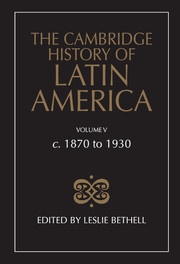Book contents
- Frontmatter
- PART ONE MEXICO
- 1 Mexico: Restored Republic and Porfiriato, 1867–1910
- 2 The Mexican Revolution, 1910–1920
- 3 Mexico: revolution and reconstruction in the 1920s
- PART TWO CENTRAL AMERICA AND THE CARIBBEAN
- PART THREE THE RIVER PLATE REPUBLICS
- PART FOUR THE ANDEAN REPUBLICSo
- PART FIVE BRAZIL
- Bibliographical essays
- References
3 - Mexico: revolution and reconstruction in the 1920s
from PART ONE - MEXICO
Published online by Cambridge University Press: 28 March 2008
- Frontmatter
- PART ONE MEXICO
- 1 Mexico: Restored Republic and Porfiriato, 1867–1910
- 2 The Mexican Revolution, 1910–1920
- 3 Mexico: revolution and reconstruction in the 1920s
- PART TWO CENTRAL AMERICA AND THE CARIBBEAN
- PART THREE THE RIVER PLATE REPUBLICS
- PART FOUR THE ANDEAN REPUBLICSo
- PART FIVE BRAZIL
- Bibliographical essays
- References
Summary
The Mexican Revolution was initiated and directed for the most part by the upper and middle classes of the Porfiriato. There were, however, several revolutions within the Revolution. The revolutionary front line was fluid and revolutionary groups were heterogeneous, with very different, even contradictory, objectives. The mass of the people, upon whom the profound changes of the period 1870–1910 had borne heavily, had only a limited sense of what was at stake in the struggle for political power. From 1913 the Sonorans, the north-west faction within the Carrancista or Constitutionalist movement, sought national political power, and in 1920 they finally seized it. The Sonoran hegemony proved complete and long lasting. In effect it was an ‘invasion’ from the north. The secular habits, the savage pragmatism and the violent struggle for survival of the north-western frontier were totally alien to the Mexican nation at large.
An ex-minister of the period, Luis L. León, has given us a clear picture of how these people of the north-west saw themselves and Mexico, and the programme they wished to impose on the country. He tells us that between 1913 and 1920, the state of Sonora was for the Sonorans their school and their laboratory, both as politicians and as men of business. They described themselves as the Californians of Mexico, who wished to transform their country into another California. Once they took on the gigantic task of controlling national resources of water and land, they were astonished to find that the centre and the south of the country were quite different from their own far north-west.
- Type
- Chapter
- Information
- The Cambridge History of Latin America , pp. 155 - 194Publisher: Cambridge University PressPrint publication year: 1986
References
- 6
- Cited by

